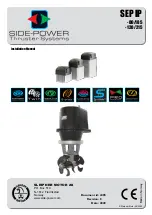
dsPIC30F Demonstration Program Operation
©
2006 Microchip Technology Inc.
DS70099D-page 35
Each DTMF tone consists of two sinusoids: a high-frequency component and a low-
frequency component. In the DTMF tones implemented for this demonstration, the
high-frequency component is at a level 8 dB lower than the low-frequency component.
You can listen to the generated tones by using either a headset or a passive speaker
connected to the “SPKR OUT” jack (J17).
If you connected your PC for the Data Acquisition Display demo (see Section 3.3.1.1),
you can use the <0>-<9> keys on the PC keyboard to select a DTMF tone.
To quit this demonstration and return to Menu Options, press switch SW1.
3.3.2
Demonstrated Features and Peripherals
The following two sections summarize the key dsPIC30F MCU, DSP and peripheral
features implemented in this general purpose demonstration program.
3.3.2.1
dsPIC30F MCU/DSP FEATURES
The demonstration program uses several unique dsPIC30F MCU/DSP features for
various processing functions, including:
• DSP Engine for FFT, FIR and IIR computations
- 40-bit accumulators with Saturation, Overflow and Rounding modes
- Multiply-and-Accumulate (
MAC)
class of DSP instructions
• Bit-Reversed Addressing for 256-point FFT input data in preparation for the FFT
“butterfly” computations
• Modulo Addressing for accessing arrays in a circular fashion for FIR filtering
- Two modulo buffers have been implemented, one each in X and Y data
spaces.
• Hardware Loop instructions
-
DO
and
REPEAT
instructions provide minimal overhead when executing a
block of instructions repetitively.
• Program Space Visibility (PSV)
- Large tables for FIR filter coefficients, sine tables etc., are stored in and
accessed from program memory.
3.3.2.2
dsPIC30F DEMO PERIPHERALS
The demonstration program also implements several dsPIC30F peripherals for various
tasks. These peripherals include:
• Timer1 – Configured as a 16-bit timer
• Timer2 – Configured as 16-bit timer with a 256:1 prescaler
• Timer3 – Configured as 16-bit timer with a 256:1 prescaler
• Timer4 and Timer5 – Configured as a 32-bit timer
• UART2 TX/RX – Used to transmit demo data to the PC and receive commands
from the PC keyboard
• SPI 2 – Used to communicate to the 122 x 32 Addressable-Pixel LCD via the
PIC18F242 LCD controller and MCP41010 digital potentiometer
• 12-bit ADC – Used to convert multiple analog signals, including temperature and
sine-wave signals generated by the MCP41010 digital potentiometer through a
low-pass filter
Note:
For a passive speaker, use a Radio Shack Model # 40-1434 Fold-up Stereo
Speaker System or an equivalent device.















































